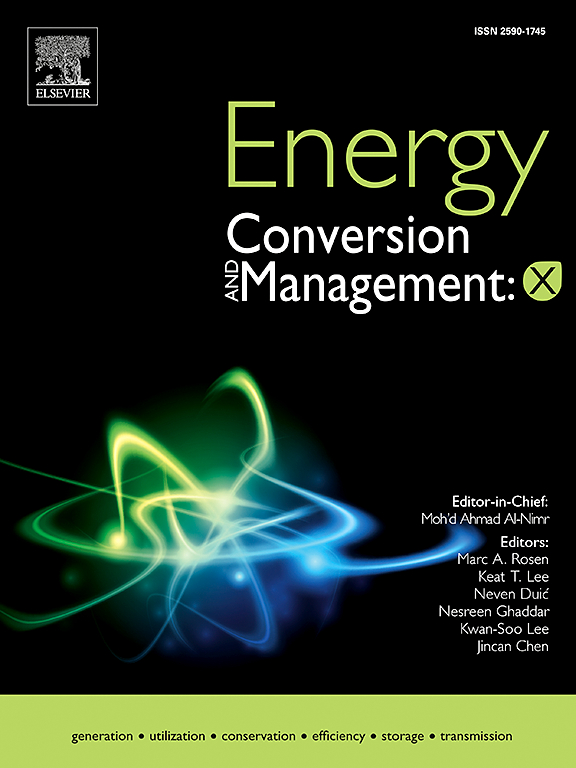欧盟碳边界调整机制和可变可再生能源一体化对化石能源系统的影响
IF 7.1
Q1 ENERGY & FUELS
引用次数: 0
摘要
碳边界调整机制(CBAM)旨在通过对进入欧盟的进口碳密集型商品实行碳定价,减少碳泄漏,促进全球脱碳。本文评估了CBAM对克罗地亚和波斯尼亚和黑塞哥维那互联电力市场的影响,分析了可变可再生能源(VRES)的部署和CBAM的合规性如何重塑能源贸易、排放和系统灵活性。该研究使用Dispa-SET模型(一种用于高可再生能源整合的多区域系统的单元承诺和电力调度工具),研究了三种情景下的电力流动、化石燃料依赖和脱碳轨迹:NECP,代表计划技术;LRES,反映低可再生能源并购率;以及可再生能源高部署的HRES。结果表明,加速部署VRES减少了对化石燃料的依赖,在HRES情景下,到2035年波斯尼亚和黑塞哥维那的二氧化碳强度降至0.85 gCO2/kWh。在NECP情景下,波斯尼亚和黑塞哥维那对克罗地亚的电力出口从2025年的3.41太瓦时下降到2035年的1.39太瓦时,但在HRES情景下稳定在2.35太瓦时。到2035年,波斯尼亚和黑塞哥维那的弃风量将增加到2.73太瓦时/年,占VRES发电量的24.2%,这凸显了管理高可再生能源渗透率的挑战。煤电运营下降、排放减少和电力出口变化之间的相互作用,突显了在确保能源安全的同时,使区域能源体系与欧盟脱碳目标保持一致的复杂性。本文章由计算机程序翻译,如有差异,请以英文原文为准。
Impact of the EU carbon border adjustment mechanism and variable renewable energy integration on fossil-based energy systems
The Carbon Border Adjustment Mechanism (CBAM) aims to mitigate carbon leakage and foster global decarbonisation by introducing carbon pricing on imported carbon-intensive goods entering the EU. This paper evaluates CBAM’s impact on the interconnected electricity market of Croatia and Bosnia and Herzegovina, analysing how variable renewable energy sources (VRES) deployment and CBAM compliance reshape energy trade, emissions, and system flexibility. Using the Dispa-SET model, a unit commitment and power dispatch tool for multi-zonal systems with high renewables integration, the study examines electricity flows, fossil fuel dependency, and decarbonisation trajectories across three scenarios: NECP, representing planned technologies; LRES, reflecting low renewables integration; and HRES, with high renewable deployment. The results show that accelerated VRES deployment reduces fossil fuel dependency, with CO2 intensity in Bosnia and Herzegovina dropping to 0.85 gCO2/kWh by 2035 under the HRES scenario. Electricity exports from Bosnia and Herzegovina to Croatia decline from 3.41 TWh in 2025 to 1.39 TWh by 2035 under the NECP scenario but stabilise at 2.35 TWh in the HRES scenario. Curtailment in Bosnia and Herzegovina rises to 2.73 TWh/year by 2035, or 24.2 % of VRES generation, highlighting the challenges of managing high renewable penetration. The interplay between declining coal power operations, reduced emissions, and shifting electricity exports underscores the complexities of aligning regional energy systems with EU decarbonisation goals while ensuring energy security.
求助全文
通过发布文献求助,成功后即可免费获取论文全文。
去求助
来源期刊

Energy Conversion and Management-X
Multiple-
CiteScore
8.80
自引率
3.20%
发文量
180
审稿时长
58 days
期刊介绍:
Energy Conversion and Management: X is the open access extension of the reputable journal Energy Conversion and Management, serving as a platform for interdisciplinary research on a wide array of critical energy subjects. The journal is dedicated to publishing original contributions and in-depth technical review articles that present groundbreaking research on topics spanning energy generation, utilization, conversion, storage, transmission, conservation, management, and sustainability.
The scope of Energy Conversion and Management: X encompasses various forms of energy, including mechanical, thermal, nuclear, chemical, electromagnetic, magnetic, and electric energy. It addresses all known energy resources, highlighting both conventional sources like fossil fuels and nuclear power, as well as renewable resources such as solar, biomass, hydro, wind, geothermal, and ocean energy.
 求助内容:
求助内容: 应助结果提醒方式:
应助结果提醒方式:


